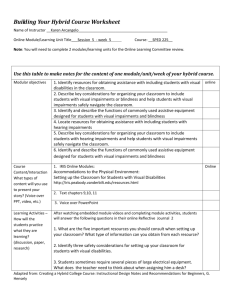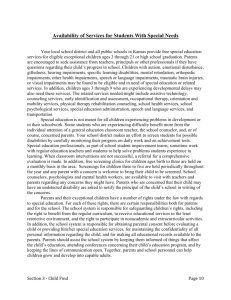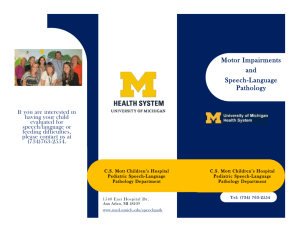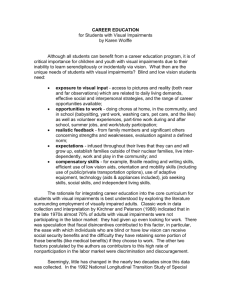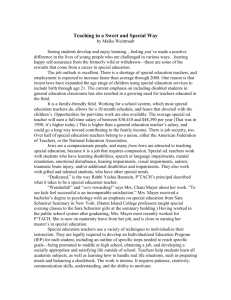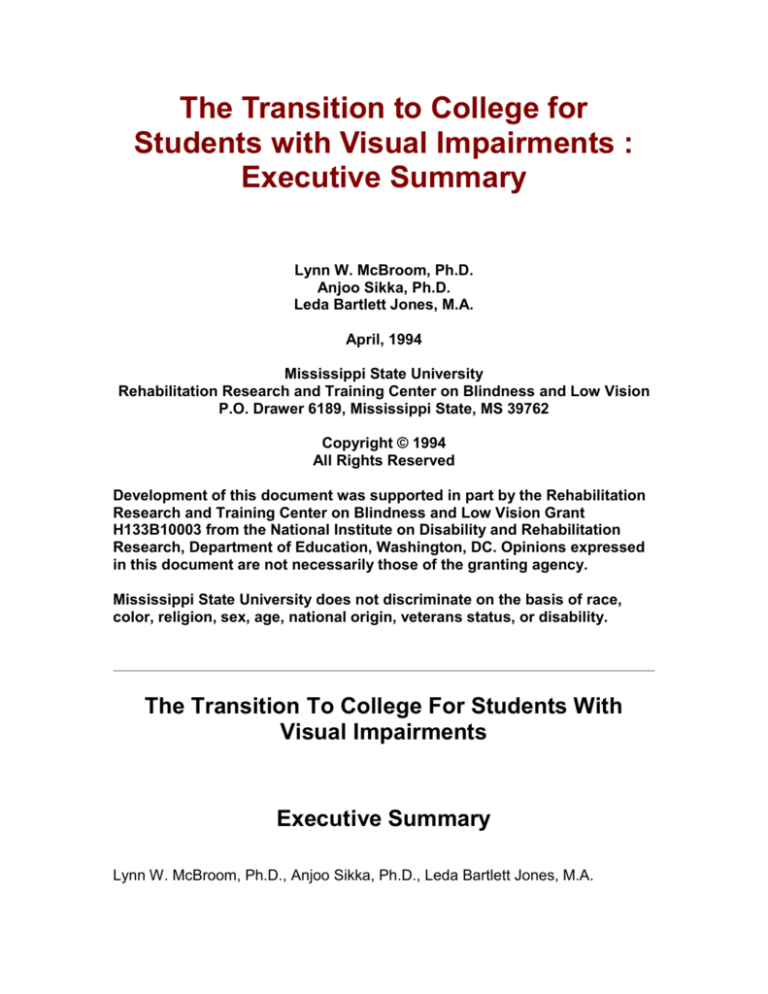
The Transition to College for
Students with Visual Impairments :
Executive Summary
Lynn W. McBroom, Ph.D.
Anjoo Sikka, Ph.D.
Leda Bartlett Jones, M.A.
April, 1994
Mississippi State University
Rehabilitation Research and Training Center on Blindness and Low Vision
P.O. Drawer 6189, Mississippi State, MS 39762
Copyright © 1994
All Rights Reserved
Development of this document was supported in part by the Rehabilitation
Research and Training Center on Blindness and Low Vision Grant
H133B10003 from the National Institute on Disability and Rehabilitation
Research, Department of Education, Washington, DC. Opinions expressed
in this document are not necessarily those of the granting agency.
Mississippi State University does not discriminate on the basis of race,
color, religion, sex, age, national origin, veterans status, or disability.
The Transition To College For Students With
Visual Impairments
Executive Summary
Lynn W. McBroom, Ph.D., Anjoo Sikka, Ph.D., Leda Bartlett Jones, M.A.
Rehabilitation Research and Training Center on Blindness and Low Vision
Mississippi State University
Introduction
Students who are visually impaired as well as those who are sighted share
similar concerns when attending college for the first time. They must register for
class, find their way around a strange campus, meet new people (and hopefully,
make a few new friends), survive dormitory life and cafeteria food, and
adequately prepare to pass their courses. Students who are visually impaired
share all these concerns and a few more which are unique to their particular
situation. How will they arrange to complete reading assignments (find and hire
readers, locate adaptive equipment for their needs, find enough time to complete
all those assignments)? How will they find their way around campus when
everyone else is just as lost as they are that first week? How will they deal with
these and other issues that someone else (teachers, parents) may have been
doing for them all of their lives? What support systems will they have when they
leave home (maybe for the first time)?
In order to encourage more students with visual impairments to enroll in college
and to remain in those programs until graduation, research is needed which
identifies skills, knowledge, and steps necessary for students with visual
impairments to enter college and to complete the required course work and
training. This study was designed to identify previous research and literature
about the transition to college. Data were collected by telephone from 102
students with visual impairments who are currently enrolled in college and who
have "survived" their freshmen year. These students offered their insights and
thoughts about succeeding in the college environment. General domains in the
questionnaire included demographics, educational history, computers,
specialized and adaptive equipment, resources, college preparation, problems
adjusting to college, work history, and orientation and mobility (O&M) skills.
Additional data were gathered from 66 college administrators about the programs
available at their schools for students with visual impairments. Administrators
were asked about services provided by their colleges, institutional expectations,
requirements for admission, and effects of the newly legislated Americans with
Disabilities Act. Administrators were also encouraged to send materials
describing their support programs for students with disabilities.
This executive summary provides a brief overview of the research process,
literature review, and research results. Interested readers should refer to the
complete technical report authored by McBroom, Sikka, and Jones (1993) for
more detailed information and explanations.
Results
Student Demographics
There were about the same number of males and females in the survey (54%
female and 46% male), however, there was a much greater concentration of
white respondents (86%) than nonwhite (14%). The average age of the
respondents at the time of the interview was 25 years with a range from 19 to 50
years. Vision loss tended to occur at birth (60% of the respondents) or at a very
early age. The majority of students (74%) were healthy and had no additional
major health problems.
The students averaged a 3.2 grade point average in high school and in college (4
represented an "A"). Twenty-two percent classified themselves as sophomores
or second year junior college students, 33% as juniors, and 45% as seniors. The
leading college majors were education, psychology, social work, business,
English, communication, sociology, health, and engineering.
Reading Methods Used by Students
In order to keep up with reading assignments, students used taped textbooks
(75%); taped class materials (64%); readers (59%); CCTV, Visualtek, or other
enlarging devices (38%); braille class materials (17%); large print textbooks
(17%); Nemeth coded braille materials (16%); and braille textbooks (8%). Other
methods were used by 24% of the students (e.g., computers, color overlays,
raised line drawings, and optical character recognition devices). Computers were
used on a regular basis for college classwork by 73% of the students.
Student Work History
The majority of students had participated in the work force in some way by the
time they were in college. During high school, 88% of the students performed
household chores, 55% performed volunteer work, 45% worked for pay during
after school hours, and 64% held summer jobs. Twenty-nine percent of the
students returned to college after first working awhile and 56% worked for pay
while attending college.
Student Extracurricular Activities
Fifty-four percent participated in social groups or organizations, 44% in scholastic
or academic organizations, 34% in religious activities, 27% in career or jobrelated organizations, 17% in political groups, 15% in athletic groups, and 12% in
sororities or fraternities. One-third of the students did not engage in any type of
extracurricular activity while in college.
Use of Services and Equipment as Reported by Students
The student respondents were asked a series of questions about whether or not
they used services or equipment provided by colleges. A majority of the students
used alternative testing arrangements (86%), computers (69%), special
preregistration for classes (60%), and college health services (55%). Following
these services in decreasing use were tutors (49%), college counseling services
(46%), campus O&M instruction (35%), tape recorders or notetakers (34% each),
transportation (30%), and college preparatory programs or typewriters (22%
each). Services used by twenty percent or fewer students were job placement
services (20%), calculators (17%), special housing arrangements (11%), and
electronic notetakers (6%).
Help Received from Others
When making any type of major change in their lives, people often turn to others
for assistance, support, or advice. The students' families were the most helpful
(average = 3.4 with a range from one to four). Sighted friends were also helpful in
the transition (average = 2.9), but friends with visual impairments were not as
helpful (average = 2.0). College representatives which included people in the
office of disabled student services averaged 2.7 in "helpfulness." Less helpful
were O&M instructors (average = 2.3), vocational rehabilitation counselors (2.3),
rehabilitation professionals including counselors or teachers (2.1), and high
school teachers or counselors (1.8).
College Preparation by Students
Students were asked how important a series of items were in their college
preparation. Items ranked as "very important" included preregistering for classes
(76%), followed by communicating with teachers (69%), ordering textbooks early
(63%), applying for financial aid (61%), learning how to manage money or
locating transportation (60% each), making housing arrangements (58%),
receiving campus O&M instruction (55%), deciding on a college to attend (54%),
and communicating with the office of disabled student services (50%). Less than
fifty percent of the students ranked the following items as "very important:" (a)
finding and scheduling readers or visiting college during orientation (45% each),
(b) working with vocational rehabilitation services (44%), (c) meeting or talking
with a roommate (30%), (d) attending college preparatory programs (29%), and
(e) deciding on a major area of study (27%).
Problems Experienced by Students While Attending College
Students were presented a list of 25 problems and asked if they had experienced
any of them while in college. Time management or access to diagrams and
charts were the two problems experienced by the greatest percentage of
students (54% each). These were followed in descending order by accessing
books and written materials (53%), having enough money or difficult classes or
assignments (49% each), and transportation (44%). The next group of problems
were only separated by one percentage point each: finding ways around campus
(39%), participating in recreational or athletic activities (38%), taking exams with
time limits (37%), accessing computers (36%), obtaining special services for their
disability (35%), and dealing with teachers and professors (34%). The problems
experienced by less than a third of the students were social pressures (31%),
receiving financial aid (30%), loneliness or finding and scheduling readers (28%
each), making good grades or writing papers (27%), making friends (24%), being
accepted (23%), getting along with a roommate or registering for classes (22%
each), locating suitable housing (21%), living independently (19%), and
managing money (12%).
Reading Medium Correlated with Problem Areas
The researchers believed that there might be a relationship between the method
of reading and certain problems experienced by students while attending college.
Chi-square test statistics showed that students who used readers also had more
problems than expected accessing books and written materials, accessing
diagrams and charts, and finding and scheduling readers. Both braille textbook
readers and Nemeth braille readers had more difficulties than expected
accessing books and written materials. Nemeth braille readers also had more
problems than expected accessing diagrams and charts. Students who used
large print textbooks had no unexpected problems accessing any classroom
materials identified in the survey, while students using enlargement devices had
fewer problems than expected accessing diagrams and charts. Students who
used taped textbooks had more problems than expected accessing books and
written materials and accessing diagrams and charts.
College Grades Correlated with Problem Areas
College grade point average was correlated with problem areas. "B" and "C"
students had more difficulty than expected with difficult classes or assignments
and with making good grades ("A" students had fewer problems than expected
for both areas). "A" and "B" students had fewer problems than expected in taking
time limited exams, however, "C" students had more problems than expected.
Response to Open-ended Questions
Students were given the chance to answer two open-ended questions: (a) "What
do you know now about college that you wish you had known when you were a
freshman?" and (b) "What advice would you give a high school student with a
visual impairment who wanted to go to college?" Their responses could be
summarized into a few general categories. Many students provided a lot of
encouragement to anyone contemplating attending college. They offered
practical advice for choosing a college and narrowing one's options. Students
with visual impairments were encouraged to be assertive, to advocate for
themselves, and to become independent and responsible. Students should work
closely with teachers, disabled student services, and other agencies to obtain
needed equipment and support, including computers, transportation, O&M, and
money. Students must learn good study habits and time management and
organization skills, as well as test-taking skills. Students were encouraged to
cultivate friendships through informal social interactions and organizational
activities because the college experience includes life outside the classroom.
Services Provided by Colleges, Now and in the Future
The 66 administrators who responded were asked about 26 services which might
be offered by their schools. The only service offered by all colleges was
alternative testing arrangements, such as extended time or readers. The other
services offered by a large percentage of the colleges were readers (97%); tutors
(97%); adaptive course work, such as extended time (96%); adapted computer
equipment (94%); and adaptive equipment (89%).
Eighty-three percent of the colleges provided cassette recorders and notetakers
to their students with visual impairments; 82%, O&M assistance; 81%, recorded
textbooks; 79%, special preregistration; 77%, extra counseling services; 76%, inservice training for professors and staff members; 71%, special orientation; and
70%, club, organization, or support groups. A majority of the colleges provided
special housing arrangements (68%), typewriters (67%), diagnostic testing for
academic placement purposes (60%), specialized resource rooms (57%),
calculators (56%), and peer or assistant counselors (54%). Forty-two percent of
the colleges provided transportation to their students with visual impairments,
41% offered large print books; 33%, braille books; 26%, college preparatory
programs; and 21%, electronic notetakers.
Summary
What Do Students with Visual Impairments Need to Know to Attend
College?
First, students with visual impairments need a good academic background to
prepare them for the rigors of college. If students have not mastered the skills
and information taught at the high school level, they will be handicapped upon
entering college; this handicap has little to do with the visual impairment. Making
good grades in high school is one of the best preparations that any student can
make to prepare for college.
Students with visual impairments must have built up a repertoire of skills to allow
them to compete at the college level. They must have good study skills,
notetaking skills, and test-taking skills. This will require the student to locate the
correct adaptive equipment and to become proficient in using that equipment.
More and more, students will have to become familiar, and even proficient, on
computers.
Students with visual impairments must be able to keep up with reading
assignments. They may have to arrange for taped, large print, or brailled
materials. In order to obtain class materials in an alternative reading medium,
students will have to work closely with teachers to acquire reading assignments
in advance. They may choose to use readers or they may invest in adaptive
equipment which allows them to read the materials for themselves. Regardless of
the method used, students with visual impairments must be able to read the
class assignments.
If a student with a visual impairment needs assistance, it is his or her
responsibility to make the initial request. Students must become comfortable
discussing their needs in relationship to their visual impairment with teachers,
administrators, other students, and personnel from disabled student services.
Armed with knowledge about their legal rights, students will be able to overcome
resistance to obtaining necessary accommodations.
Students with visual impairments must learn how to do things for themselves.
This is a part of growing up. Readers may have to be located, hired, trained, or
fired. The student should be able to make arrangements for their own readers.
Textbooks may have to be ordered in advance. The student should learn where
to order books and then take on this task for him or herself. Students will have to
travel from dormitories (or from other types of housing), to classes, to the
cafeteria, and back again. The student should learn those routes and alternative
methods to compensate for late rides, inclement weather, or rescheduled
classes. These are only a few examples of the need for students to establish
their independence and to develop responsibility for themselves.
It requires money to attend college. Students with visual impairments have
sources of money available through vocational rehabilitation which are not
available to sighted students. Financial aid application requirements are often
rigid, so students must be prepared to meet other's schedules and requirements
in order to receive funds. Other sources of money include family resources and
self-payment. Whatever the source of funds, students will have to learn how to
manage their money because the amounts received are, somehow, never
enough.
Many respondents in this study worked for a period of time before enrolling in
college. Even those who did not work for pay, often participated in volunteer
activities. Many of the students stressed the importance of joining an
organization or interest group in order to network, gain information, and develop
supports.
The biggest problems encountered by students in this study were managing their
time; accessing diagrams, charts, books, and written materials; having enough
money; and overcoming difficult classes or assignments. The next most
frequently mentioned problems were finding and utilizing transportation, finding a
way around campus, participating in recreational or athletic activities, taking
exams with time limits, accessing computers, obtaining special services, and
dealing with teachers. Coping with social pressures was the next leading
problem, followed by receiving financial aid, loneliness, finding and scheduling
readers, making good grades, writing papers, making friends, being accepted,
getting along with a roommate, registering for classes, locating suitable housing,
living independently, and managing money.
If future students could closely examine this list of common problems, see which
ones might apply to them, and take remedial steps to overcome those problems
before they occur, they might be better prepared for college. Regardless of the
circumstances, potential students can take comfort from one student who
advised that the first year of college is the hardest; it does get better!
What are the Specific Steps that Students with Visual Impairments Need to
Take in Order to Successfully Attend College?
Students with visual impairments thinking about college should begin early to
make their plans. They must satisfy the requirements of the college, scholarship
granting agencies, and vocational rehabilitation. This process does take time to
complete.
Students should fully research their options. They must know what they want to
accomplish and then set out to meet their goals. Some of the students in the
study delayed their college education in order to work for awhile. Students
planning to attend college should know that these students were doing quite well
at their studies when they did return to college.
The extensive technical report (McBroom, Sikka, & Jones, 1993) lists a detailed
set of activities which should be accomplished by a certain time in order to attend
college following high school graduation. A much shortened version is presented
here. A potential college student should adapt the list to his or her particular
circumstances.
The junior high student with a visual impairment can begin exploring their career
options, as well as concentrating on their studies.
Ninth grade students can continue to explore their career options and include
vocational activities in the annual IEP. The guidance counselor can help by listing
preparatory classes needed for college and working with the student to
determine if this plan of study can be met. Standardized achievement tests
should be ordered in an accessible format for the student. The student can make
initial contact with the vocational rehabilitation counselor. Participation in
extracurricular activities, clubs, and organizations is important for college
preparation. If the student has not done so already, he or she can obtain a public
library card, apply for membership in the Library for the Blind, and register with
Recordings for the Blind.
In the tenth grade, the student may continue to explore his or her career options
and again, include vocational activities in the annual IEP. Meetings with the
vocational rehabilitation counselor will continue. The student will complete
standardized achievement tests, review results with the guidance counselor, and
arrange for necessary tutoring. At this point, the tenth grade student should begin
researching possible colleges. Participation in extracurricular activities, clubs,
and organizations should continue. The student may consider taking a job or
becoming a volunteer. It may become necessary for the student to enroll in a
summer enrichment program to learn braille, computer skills, O&M, study skills,
etc. The student should obtain a Social Security card, an identification card, and,
if necessary, a reduced fare card from local transportation systems.
Exploration of career options and inclusion of vocational activities in the annual
IEP should continue in the eleventh grade. The student will also continue to meet
with the vocational rehabilitation counselor; participate in extracurricular
activities, clubs, and organizations; and work or volunteer. The student should
continue to research possible colleges by reviewing their catalogs. The student
can begin to reduce the list of possible colleges. College expenses should be
discussed with parents and the student can register for scholarships and financial
assistance. The student should begin to visit college campuses and obtain
college application forms and information about application procedures, time
frames, and financial aid. The student may once again, enroll in summer
enrichment programs to gain needed skills. The student should also register to
take standardized college admission tests in an accessible format.
The high school senior has a lot to accomplish during the year. Career options
may become more definite and the annual IEP should reflect this. Meetings with
the vocational rehabilitation counselor should include discussions about college
options, community support services, vocational rehabilitation services, and state
and national organizations. Participation in extracurricular activities, clubs,
organizations, jobs, and volunteer work will continue. The list of colleges will be
further reduced. All applications should be completed and mailed by their
deadlines. The student should complete standardized admission tests and send
scores to selected colleges. During this time, the student should register for
scholarships, complete all health and immunization requirements, and continue
to meet all deadlines. The student will want to complete all initial college visits
and then revisit the top college choices to inquire about financial aid,
scholarships, and services for students with disabilities. Once acceptances
arrive, the student can select a college to attend, pay deposits (including
housing), and complete all necessary paperwork. The student may choose to
discuss his or her needs with the college's office of disabled student services.
Throughout the year, the student must continue to maintain good grades.
Do Skills, Knowledge, and Steps Differ from the Perspective of Students
Versus Program Administrators?
In one way, the goals of the students and administrators do not differ. Both
groups want students to obtain a college education. However, the emphasis is
sometimes different because of separate priorities. The student only has to be
concerned about completing his or her own college requirements, while the
college administrator has hundreds or thousands of students with whom to deal.
Students with visual impairments will have to begin their college search early to
find a college that best meets their academic requirements and their need for
adaptations and services. Students should understand that they are just one
among many individuals who make requests for special services. Some
accommodations simply take time to accomplish, so students should allow for
that delay.
If students with visual impairments need assistance, it is their responsibility and
obligation to ask for help. It is not the college administrator's responsibility to
seek out students, however, they should make the services as easy to access as
possible. College students may have developed a rigid set of requirements for
adaptive equipment. College administrators are not required to provide any
particular piece of equipment, but they must work with the student to make sure
that an acceptable adaptation is provided. Students should be prepared to offer
suggestions and solutions and not just problems. Sometimes the administration
is amenable, but they simply do not know what is expected or what is available.
Students with visual impairments should not expect and should never ask for
adaptations or services that place them at an advantage over other students.
Administrators should allow only those adaptations that place the student in the
same competitive setting as all other students. All students will not pass their
courses or graduate from college, and neither will all students with visual
impairments.
Administrators in this study tended to agree that the Americans with Disabilities
Act will result in increased awareness of disability issues among their faculty,
staff, and students. Those schools that made a sincere commitment to Section
504 of the Rehabilitation Act of 1973 will have less difficulty complying with ADA.
ADA will probably result in more students with disabilities attending college,
including those with visual impairments.
From a list of services provided by colleges, students in this study were asked
which ones they used. Administrators were also asked to mark those services
that were used by students at their schools. The listing of services for students
and administrators was not entirely compatible, therefore, any comparison
between the two sets of responses will be tentative.
The top group of services as reported by students were alternate test
arrangements, computers, special preregistration for classes, college health
services, tutors, college counseling services, readers, and adapted reading
formats. All of these services were reported by a high percentage of
administrators as services offered by their colleges and used by their students
(except for college health services, which was not included on the administrators'
list). Administrators of college programs might want to continue strengthening
these services, based on their use by students with visual impairments.
In summary, students with visual impairments can successfully attend college
with their sighted peers if supporting services are available. Based on interviews
with students and administrators, this summary has briefly described the types of
skills and information that students with visual impairments need to know to
attend college, the specific steps that should be taken to achieve this goal, and
some of the differences in the perceptions of students and administrators.
References
McBroom, L. W., Sikka, A., & Jones, L. B. (1993). The transition to college for
students with visual impairments (Technical Report). Mississippi State, MS:
Mississippi State University, Rehabilitation Research and Training Center on
Blindness and Low Vision.



